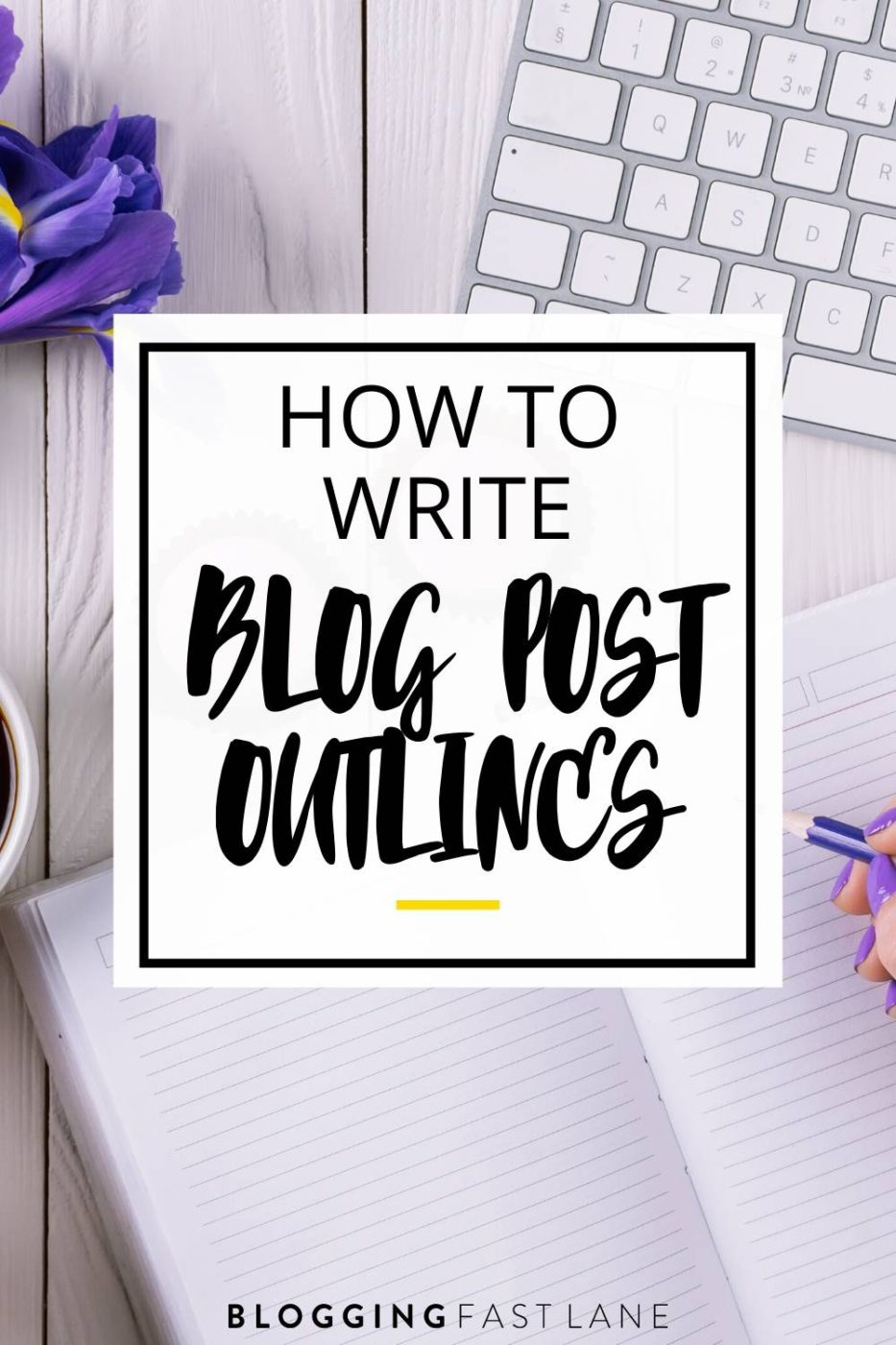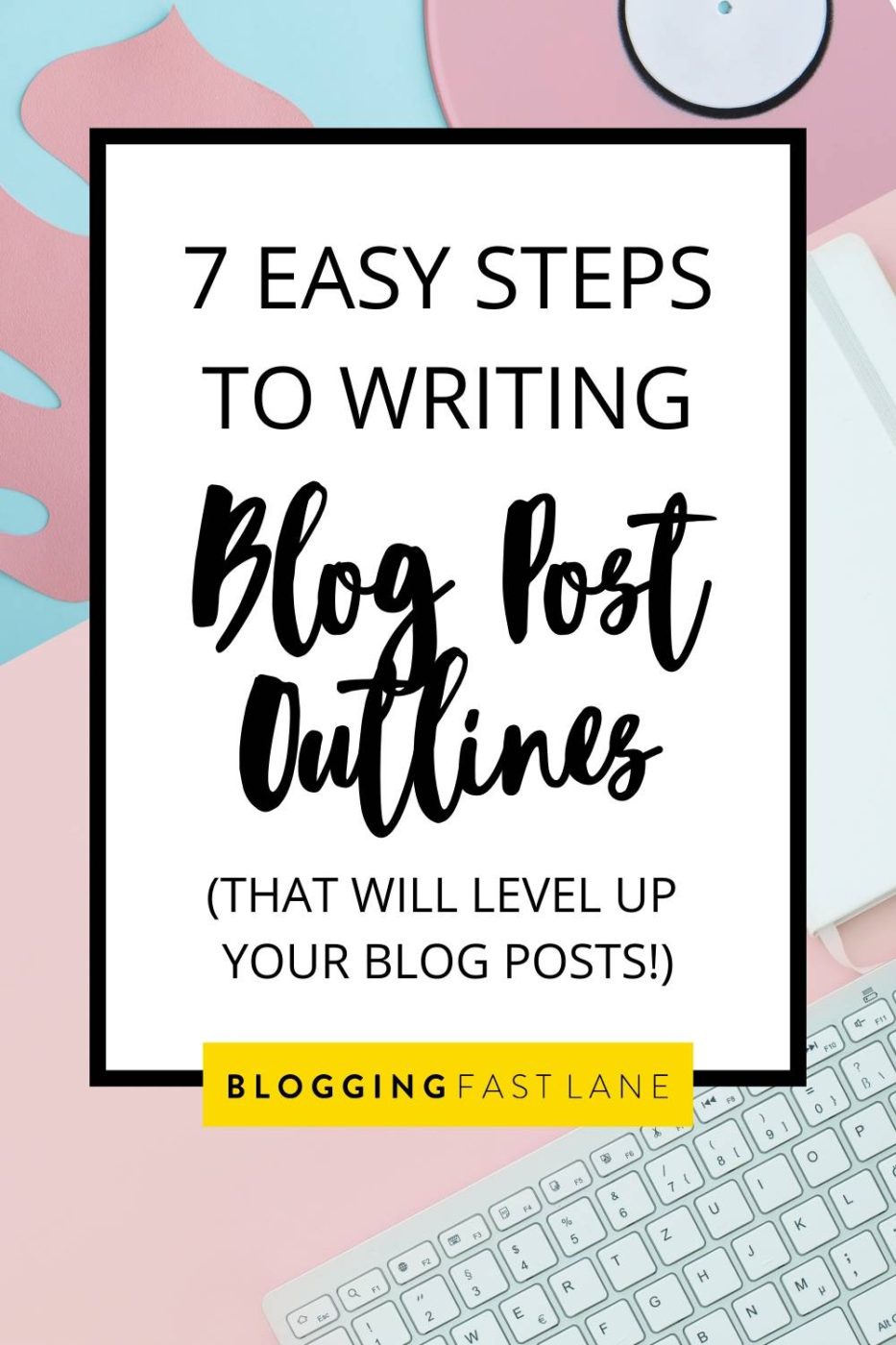This article may contain affiliate / compensated links. For full information, please see our disclaimer here.

Are you a planner or a pantser? In the fiction writing world, authors generally fall into 2 camps: those who plan and plot their stories (planners) and those who fly by the seat of their pants (pantsers).
The same concept can be applied to blogging. Do you dive straight into writing your blog posts or do you create blog post outlines before you even write a word?
As a former blogging pantser, I’m here to share with you why blog post outlines are so effective and how exactly you can create a blog post outline in just 7 simple steps.
- Why Create a Blog Outline
- How to Outline a Blog Post in 7 Steps
- Step 1: Determine the Topic and Keywords for Your Blog Post
- Step 2: Check Out the Top Ranking Articles
- Step 3: Nail Down What You Want Your Readers to Get from Your Post
- Step 4: Brainstorm the Key Information You Should Include
- Step 5: Start Outlining Your Blog Post
- Step 6: Review Your Blog Post Outline
- Step 7: Write Your Blog Post
- Do You Always Need a Blog Outline?
Why Create a Blog Outline
You’re probably wondering, “why do I even need a blog outline? I just want to start writing!”.
Creating an outline may just seem like an extra step and wasted time… but after years of blogging and writing hundreds of articles, I’ve come to realize that outlining a blog post before you start is absolutely essential.
Here’s why.

Provide Structure and Flow to Your Blog Post
A good blog post consists of many different elements. Strong writing style, good grammar, and being able to comprehensively cover all the important information around the topic.
But above those things mentioned above, what can elevate your blog posts from good to great is having a strong structure and good flow.
What exactly does this mean?
Have you ever read a blog post that seemed poorly thought-out? It jumps from one point to another and then back to the first point. Or it just sounds like stream-of-consciousness writing and it’s hard to grasp the points that the writer is trying to make. Maybe the information is haphazardly presented and it’s difficult to follow along.
Or worse yet, have you ever clicked on a link, read a blog post, and then gotten nothing from it? It’s a bit deflating to read an article with the expectation of learning some new information or picking up a new skill… but then realize that the blog post doesn’t really have any meaningful substance.
In today’s world, where there are millions and millions of blog posts out there, it’s not enough to just write good blog posts – you need them to be great.
Creating a blog outline will absolutely help you develop your ideas and bring structure and flow to your blog posts. The act of outlining will enable you to organize your thoughts and lay out the information you’d like to impart to your readers in a clear, cohesive way.
For your readers, this means that when they read your blog post, it’s easy to follow along and digest the topic… and it’s also easy for them to go away and take action on what they’ve learned afterwards.
The bottom line is that creating a blog outline will enable you to provide value to your readers… and that’s what will keep people coming back to your blog.
Help You Produce the Best Piece of Content (and Outrank Your Competitors!)
Related to the first point above, one important benefit of outlining a blog post is that it can help you produce the best piece of content on the topic.
In order for your blog posts to rank well on Google, it should be a comprehensive article that answers the readers’ questions on the topic.
With a blog outline, you can put some thought into how to produce an article that will outrank your competitors while still providing value for your readers.
Put yourself in your reader’s shoes and consider the topic from their point of view. Think about things like what are they looking to learn, what information do they need to take action, and what could make their lives easier or more convenient.
When you’re outlining your blog post, you can ensure that it is chock-full of valuable information and not just a piece of fluff that your readers will gloss over.
A blog outline can help you organize all this information in a way that is easy to digest and understand… thus, solving your readers’ problems and making you one of the go-to resources on the topic!

Jumpstart Your Writing Process
Do you ever have one of those days when you’re sitting in front of your laptop, empty document open… but the words just aren’t coming to you?
If you’re keen on making blogging part of your life, this will be a common scenario, believe me! I’ve definitely had days when I had no motivation to start writing or worse still, just didn’t know where to start.
Here’s where having a blog outline can be a godsend.
If you don’t yet have a blog outline for a post you’re planning, working on creating one can help jumpstart your writing process.
For one, you’re not actually writing in detail but looking at the selected topic in a more big-picture way. This approach can take you out of your writer’s block as you do more research and put more thought into what exactly this blog post should include.
The outlining process is an easy way to get your writing engine revving and before you know it, you’ll have a complete outline and be excited about actually writing it!
And if you’ve already outlined your post and are having an unmotivated moment, having a blog outline to work off will make it easy for you to break the task of writing into smaller, more manageable pieces.
With an outline, you can start working on a section that’s easier to write and save the more challenging stuff for tomorrow.
Stay Focused and Save Time Writing
For me, writing a blog post without an outline often means losing momentum as I try to figure out on the fly what should come next. And it’s even worse if I get stuck and don’t know how to proceed!
I’ve found that having a blog post outline makes the writing process so much smoother because I can simply focus on the ideas that are in the outline. There’s no need to think in the moment because I’ve done it during the outlining.
Instead, I can focus on fleshing out those ideas and finding the best ways to convey the information that I want to.
This clarity means that I save so much time writing! I can keep focused on the topic at hand and I know exactly what comes next.
Basically, working off a blog post outline puts me in the flow state when I’m writing.
Whether you’re blogging full-time or working on your blog on the side, time is a precious commodity for us all. Instead of spending days and days agonizing over a blog post, try first creating a blog outline before you start writing.
I promise that it will make it so much easier for you to then actually write it!

How to Outline a Blog Post in 7 Steps
Now that you’re (hopefully) convinced about how useful blog post outlines are, it’s time to get into the process of how to outline a blog post.
Here is my 7-step process on how to create an outline from scratch. And I’ll be including a working blog post outline so that you can actually see the process in action.
Let’s get into it.
Step 1: Determine the Topic and Keywords for Your Blog Post
If you’ve been reading our BFL blog posts for a while now, you probably already know that we’re huge proponents of creating a content strategy based on keyword research.
So it’s unsurprising that the first step of outlining a blog post is to use keyword research to determine your blog post topic and its keywords.
Doing keyword research is a sure-fire way to ensure that you’re creating blog posts that your readers are actually interested in and it’ll help you identify the problems that your audience is looking to solve.
While there are free keyword tools out there, we think it’s totally worth it to invest in a paid tool that can give you more comprehensive data. We highly recommend Keysearch. It’s super affordable at only $17 per month and the data you can get from using it is so valuable in helping you put together a content plan that will rock.
Tip: Use our Keysearch coupon code “FASTLANE” to get 20% off your subscription! Click here to sign up.
Let’s use this blog title as an example.
The idea was to guide bloggers on how to write better blog posts and be more efficient in writing, and so I decided that sharing my process of outlining a blog post would be a helpful illustration.
Using Keysearch, I plugged in “blog post outline” to check if it’s a keyword worth targeting.
As there’s decent search volume and a fairly low competitive score, I decided to go with this as my main keyword.
I also took a look at the related keywords and picked out a few that I could include in the article. I make sure that I use these secondary keywords in some of my other headings throughout the article. This helps Google “read” my article even more, and this sends signals of what my content is all about.
I also recommend doing research on more long-tail keywords. In this case, I looked up “how to write a blog post outline”.
These results yield even more useful related keywords that I can incorporate into the article.
For more on how to use Keysearch to do keyword research, check our Keysearch review and guide.
Step 2: Check Out the Top Ranking Articles
Once you’ve found the keywords to target for your blog post, the next thing to do is to check out the content that’s already ranking.
If you have Keysearch or another paid keyword tool, then the keyword search top results will show up there and you can easily access them.
Here’s the list of top articles that were on the Keysearch results.
The advantage of having a keyword tool is that you also get some back-end data on the sites that are ranking on the first page.
In this instance, if you take a look at the DA (Domain Authority) column, you’ll notice that only the top 3 sites have high DAs whereas the others have average DAs. This means that there’s a chance that this article could rank well if I pack in loads of valuable information that would help readers.
If you’re a new blogger and your DA is low, do not get discouraged! We’ve seen great articles outrank blogs with high DA’s just as long as they have good SEO and authority on the subject.
But if you don’t have a keyword tool, an easy peasy way to do this is simply to plug in those keywords into Google (I’d suggest using an incognito browser window to do this) and see what comes up.
Here’s what comes up when I look up “blog post outline”.
Go ahead and read the top 3 articles. Take note of the structure of the blog posts, what kind of information they cover, and how comprehensive the article is. At this point, you may also want to note the titles for the articles as this can help you later on in the writing process when you have to come up with a catchy headline.
I love looking at the top ranking articles for the keywords that I target because it gives me a really solid benchmark of how good my own article has to be in order to try and get on the first page as well.
There’s one more piece of key information on the SERPs page: the “People Also Ask” section.
The questions here give direct insight into what your readers are having trouble with and what solution they need! This can help you with the overall writing process.
Remember: the goal of writing each article is to satisfy the user intent or problem. By making sure you consider all possible questions that readers might have about the topic, you are making sure your article will provide them with all the information that they need.
Step 3: Nail Down What You Want Your Readers to Get from Your Post
Now, it’s time to fire up your Word or Google Doc!… or open up your notebook, if you’re a pen-and-paper kind of writer.
It’s time to put your thinking cap on.
The one question you should answer at this stage is: What end results do you want after the reader has finished reading the post?
There can be so many different answers to this question, and it all depends on the topic and keywords you’ve selected.
Using the keyword “blog post outline” as an example, the goal of this blog post you’re reading is to convince you of how valuable a blog outline can be and to teach you exactly how to create your own in an easy-to-follow format.
So take a few minutes and write down the 2 to 3 key takeaways you want your readers to get from your blog post. They will help provide you with direction as you further flesh out your blog post outline.
Step 4: Brainstorm the Key Information You Should Include
Now that you have the big picture in mind, it’s time to zoom in a little bit.
In this step, you’ll brainstorm the information that you need to include in your blog post. Here’s where it’s helpful to put yourself in the shoes of your reader. What questions would they ask? What details would they need in order to solve their problems? What little tips and tricks could help make their lives more convenient or easier?
If you’re sharing something that you’re an expert in, consider what information would be helpful to someone who’s completely new to the topic and has zero knowledge. What can you say that will deepen their knowledge and understanding?
You may also want to consider if there’s any external data or authoritative information sources to include that would strengthen your blog post.
At this point, there may be questions that you don’t have the answers to. That’s okay – it’s perfectly normal that a blog post would need some research in order to fill in any gaps in information.
For this blog post, these were some of the questions that came to my mind when I was at this stage of outlining:
- Why is outlining important?
- What are the different steps to create a blog post outline?
- What tools (if any) are needed during the outlining process?
- Are there any tips on how to outline more easily?
- Is an outline always necessary? If not, in which cases can a blogger go without one?
- How long does it take to outline a blog?
In the stage, I also like to go back to the top ranking articles for the keyword and see what information they have and whether anything is lacking. If there is, then I’ll be sure to include that in my post!

Step 5: Start Outlining Your Blog Post
All right, now it’s time to get working on your actual blog outline!
Since you’ve nailed down the big picture of the article, it becomes much easier to organize all your ideas and start deciding on the flow and structure of the blog post.
When it comes to actually creating the outline, I like to start with organizing the main ideas of the article by phrasing them in possible headings and then arranging them in a logical order.
Each heading should cover one big idea and then you can zoom in further on each of them.
For the outline for this blog post, the skeleton first looked like this:
| How to Write a Blog Post Outline Intro Why a Blog Outline is Important How to Outline a Blog Post Conclusion |
Once I’m happy with the main skeleton, it’s time to expand on each main section so that I have an idea of what information will be covered.
| How to Write a Blog Post Outline Intro Why a Blog Outline is Important – Jumpstart your writing process – Save time writing – Provides structure and flow – Ensure you provide value to your readers – Results in a much stronger article How to Outline a Blog Post – Determine the topic and keywords – Do competitor research – Nail down the key takeaways you want your readers to get – Brainstorm the key information to include – Start outlining – Review and revise your outline – Write your blog post Conclusion |
Then, I further add on any other important sub-points to include to ensure that I address them within the article. I also assess the headings themselves and see if keywords can be incorporated and if the phrasing can be improved to make each point more effective.
Here’s what the more fleshed-out version looked like.
| How to Write a Blog Post Outline Intro Why a Blog Outline is Important – Jumpstart your writing process (a) An outline as a way to begin the writing process (b) An outline can help you start writing an article when you have writer’s block – Save time writing – Provides structure and flow (a) Structure and flow are what can elevate an article from good to great (b) An outline helps you develop ideas in a logical way – Ensure you provide value to your readers – Results in a much stronger article How to Outline a Blog Post – Determine the topic and keywords (a) The importance of keyword research (b) Include short overview of simple keyword research process with Keysearch – Do competitor research (a) Check out ranking articles to see what works and what readers are clicking on (b) Start thinking about how you can create an even better blog post! Nail down the key takeaways you want your readers to get (a) Each blog post should have a goal (what do you want your readers to be able to do after reading it?) – Brainstorm the key information to include (a) Put yourself in your readers’ shoes (b) Any supporting data or articles to mention/include (c) What do you already know and what don’t you know yet? – Start outlining (a) Organize your ideas in a way that makes sense for the readers (b) Flesh out your ideas – Review and revise your outline (a) Refine what you have so far (b) Consider if your content is staying on-topic or has it veered off? (c) Have you missed out anything? – Write your blog post Conclusion |
So now you’re probably wondering, “how long does my blog post outline need to be?”
A lot of it is based on your personal preference. Some bloggers may outline something similar to the first version I shared which has just the headings for the article whereas others prefer to flesh it out the way I have in version 3… or even go into deeper detail!
It’s all up to you. You may have to experiment a bit to see how in-depth you want to go in your outlines.
Remember that the aim of a blog outline is to organize your ideas and thoughts in a cohesive way so that you can write the best possible article on the topic. So, take the route that works best for you!
Step 6: Review Your Blog Post Outline
Your first outline is drafted – congratulations!
But before you move on, take a moment to review it. Here are my suggestions on how to do this:
- Read the outline from beginning to end. Consider if you have missed out anything important or if any additional points come to your mind now.
- Refer back to the top ranking articles. Compare your outline to them and assess if there’s anything else you can do to improve yours. Maybe it’s organizing the information in a more logical way, including more helpful information, or answering questions that aren’t covered in those articles.
- Edit. Lastly, revise your outline where necessary. This could mean trimming points that don’t add to the main topic, removing anything repetitive, or changing the order of the headings.
Here’s a look at the final blog outline for this post, after the review process. You’ll see that some points were rephrased for clarity and some of the headings were moved around to improve the flow of information.
| How to Write a Blog Post Outline Intro Why Create a Blog Outline – Provides structure and flow (a) Structure and flow are what can elevate an article from good to great (b) An outline helps you develop ideas in a logical way – Help you produce the best piece of content (and outrank your competitors!) – Jumpstart your writing process (a) An outline as a way to begin the writing process (b) An outline can help you start writing an article when you have writer’s block – Stay focused and save time writing How to Outline a Blog Post in 7 Steps 1. Determine the topic and keywords for your blog post (a) The importance of keyword research (b) Include short overview of simple keyword research process with Keysearch 2. Do competitor research (a) Check out ranking articles to see what works and what readers are clicking on (b) Start thinking about how you can create an even better blog post! 3. Nail down the key takeaways you want your readers to get (a) Each blog post should have a goal (what do you want your readers to be able to do after reading it?) 4. Brainstorm the key information to include (a) Put yourself in your readers’ shoes (b) Any supporting data or articles to mention/include (c) What do you already know and what don’t you know yet? 5. Start outlining (a) Organize your ideas in a way that makes sense for the readers (b) Flesh out your ideas 6. Review your blog post outline (a) Refine what you have so far (b) Consider if your content is staying on-topic or has it veered off? (c) Have you missed out anything? 7. Write your blog post Do You Always Need a Blog Outline? |
Step 7: Write Your Blog Post
Ready, set… GO!
Now that you have your final blog post outline, you’re 100% ready to get started writing your blog post. With this skeleton already done, you know exactly how to tackle this article from top to bottom and you’ll whiz through your writing in no time!
It takes some upfront work but I’ve found that having a blog outline ultimately saves me so much time, keeps me focused on the topic of the article and the valuable information I want to share, and ensures that I produce a top-notch article every time.
If you want to level up your blog posts, check out our article on how to write killer blog posts that people will keep reading.

Do You Always Need a Blog Outline?
If you’ve reached this point of the article, you’re probably thinking that writing a blog outline looks like a lot of work.
I’ll be honest: it does take some effort. But I believe that the benefits you’ll experience will completely outweigh it.
Our content team religiously uses blog post outlines in our writing process and it helps us tremendously in terms of consistently putting out high quality articles and cutting down time in the editorial process.
And you’ll get these same benefits even if you’re a solo blogger!
Planning out your blog post will definitely help you become a better writer and you’ll be able to consistently write great, valuable pieces of content for your audience.
There may be some instances where it feels easier to simply “freestyle” your article, such as sharing a personal story or experience or if you’re writing on a topic that doesn’t require much structure.
But in my opinion, if you’re serious about building your blog into a business, creating blog post outlines will help you come across as professional, authoritative, and knowledgeable. And they’ll enable you to provide high-value content to your readers so that they’ll keep coming back.
I hope you’ve found this guide to creating blog post outlines helpful!
If you’re looking for more guidance on how to create amazing content that will drive massive traffic to your blog, check out our free training where we share how we grew our travel blog into a 6-figure business.
Like this Article? Pin it!


